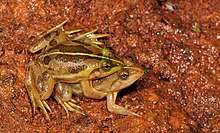Euphlyctis aloysii
Euphlyctis aloysii is a species of frog in the family Dicroglossidae. It is endemic to Karnataka, southwestern India. It was described from a female holotype from Mangalore, Karnataka.[2]
| Euphlyctis aloysii | |
|---|---|
 | |
| Adult male from Manipal, Karnataka | |
| Scientific classification | |
| Kingdom: | Animalia |
| Phylum: | Chordata |
| Class: | Amphibia |
| Order: | Anura |
| Family: | Dicroglossidae |
| Genus: | Euphlyctis |
| Species: | E. aloysii |
| Binomial name | |
| Euphlyctis aloysii Joshy, Alam, Kurabayashi, Sumida, and Kuramoto, 2009[1] | |
Description
Adults are small compared to other members of this genus; head is wider than long; snout appears pointed; nostrils are closer to the tip of snout rather than the eye; the nostrils are farther apart as compared to the distance between the eyes; tympanum is distinct and large, forming nearly 75% of the eye diameter; no webbing between fingers; first finger longer than the second but smaller than the third; foot longer than the femur and shank length; toes moderately pointed; fourth toe longer than others; webbing between toes are full, reaching the tips of all toes and sharply incised between toes; inner-metatarsal tubercle is indistinct; supratympanic fold present, but does not reach the base of arms; dorsum interspersed with small, rounded ridges; flanks, thigh and venter are smooth; a pair of dermal projections seen from anterior edge of forelimbs until groin.[1] Phylogenetic analysis indicates that E. aloysii is closely related to E. hexadactylus and another potentially un-described species.[3]

Color in life
Dorsum appears greenish brown with a thin, greenish mid-dorsal line running from tip of snout to vent; upper jaw near snout appear greenish as do the flanks, with the green coloration reducing gradually towards the groin. Based on the coloration, the adults of this species may be confused with juveniles of E. hexadactylus.[1]
Etymology
This species is named in honor of Aloysius Gonzaga, a prince in Italy who entered the Jesuit order and died in Rome, serving people during an epidemic plague.[1] The institution where one of the authors completed most work in describing the species is named after St. Aloysius as well.[1]
Ecology and natural history
The ova in female specimens are pigmented and about 1 mm in diameter. Gravid females have been collected from the months of May until late July and implied that they may spawn in early August. E. aloysii co-occurs with other congeners such as E. hexadactylus; E. cyanophlyctis and E. karaavali. Other species include Hoplobatrachus tigerinus, Microhyla ornata, Minervarya sahyadris, Minervarya caperata and, Indosylvirana intermedia.[1][3]

Distribution
Currently known from Adyar and Bajpe in Mangalore and Manipal in Karnataka.[1][3]
References
- Joshy, S. H.; M. S. Alam; A. Kurabayashi; M. Sumida & M. Kuramoto (2009). "Two new species of the genus Euphlyctis (Anura, Ranidae) from southwestern India, revealed by molecular and morphological comparisons". Alytes. 26: 97–116.
- Frost, Darrel R. (2019). "Euphlyctis aloysii Joshy, Alam, Kurabayashi, Sumida, and Kuramoto, 2009". Amphibian Species of the World: an Online Reference. Version 6.0. American Museum of Natural History. Retrieved 11 January 2019.
- Priti, Hebbar; Naik, Chandrakanth Rukkappa; Seshadri, Kadaba Shamanna; Singal, Ramit; Vidisha, Madhava Kulkarni; Ravikanth, Gudasalmani & Gururaja, Kotambylu Vasudeva (2016). "A new species of Euphlyctis (Amphibia, Anura, Dicroglossidae) from the West Coastal Plains of India". Asian Herpetological Research. 7 (4): 229–241. doi:10.16373/j.cnki.ahr.160020.